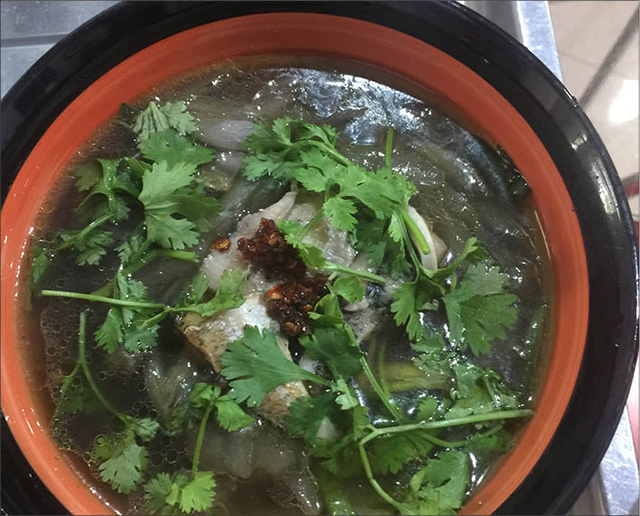In these days, few of the young generation know of and call it by the correct name. However, purple taro is very familiar to those born in the 1980s and earlier, because the popular soup made from this plant could be an alternative to rice in days of hardship or was served as a change of taste in wealthier families.

Purple taro soup is the dish for any time of the year.
In former days, many families in my hometown grew purple taro on a planting plot right beside a “crossing road” (the road connecting two villages or communes). The plot was mainly for local produce, pepper, potato, cassava, etc., but purple taro is the most profitable investment, therefore, families rich in labor usually opt for purple taro.
Actually, cultivating purple taro is not too difficult. After the soil is ploughed, saplings are sowed (saplings can be bought from the market or germinated at home) fertilized, watered, and tubers can be collected after 3 months. This kind of plant barely suffers from pests or diseases, so using pesticide is not necessary. However, it is a must that the plants always have enough water. For this reason, the plant is only grown in planting plots in immediate proximity of the house in case natural water sources run out, farmers do not have to carry water all the way far from their places.
It is also the reason why few farmers grow purple taro. The fewer people grow it, the more valuable purple taro becomes. One purple taro plot sells much higher than one potato plot by several hundred thousand VND.
In harvest season, my mother sells two plots of purple taro wholesale to the traders. She lets them dig up and carry the tubers away on their own. All the same, it never slips her mind to put aside a few tubers for later use. Whenever needed, she just has to pull up the tubers, clean, peel and cook them with wild snakehead fish or loach fish or prawns, etc., which are all tasty.
Eating purple taro quite often, and helping my mother in the kitchen regularly have taught me how to cook the dish for my whole family. After the tubers are dug up or bought from the market, they are cleaned, peeled off and chopped up into small, thin cubes so that it would take less time for them to be cooked thoroughly. As for the boles, peel off the outer layer, chop into small pieces diagonally and wash with water. Keep in mind that while washing the taro, only keep them in a basket and dip the basket in a pot filled with water, rock the basket many times and change the water constantly. Moreover, you should not touch the taro with your bare hands. If you do, put on gloves to prevent itchiness and irritation.
Rinse then drain the purple taro. Clean the snakehead fish, marinate it with spices; it would be better if we use chives because chives will discard the odor of fish. Heat the pan with oil and then fry chopped onions and chives, then add the snakehead fish and slow cook it so that all the spices could be absorbed into the fish. Afterwards, remove the bone from the fish, slow cook the fish for some more time. Meanwhile, put purple taro into a saucepan, pour in a moderate amount of water and cook it.
In the meantime, mix shrimp paste with water, and pour the mixture into the saucepan with the purple taro then cook it until it boils. Let it boil for another five minutes then add some oil to soften the purple taro. Finally, add the cooked snakehead fish and stir well with a spoon. Do not use chopsticks to stir to avoid the taro becoming ‘tickling’. When the soup starts to boil, pour a small amount of rice flour, or tapioca starch or arrowroot starch… well mixed with some water into it. When the soup boils, ladle the soup into a big bowl and decorate the dish with some chopped coriander or onions on the top.
This dish can be served both hot and mild without making any difference to its peculiar taste. We can also serve the dish with rice, or without rice if we use broken rice grains to cook instead of starch, which still retains the flavor of each of the ingredients.
At present, it is not easy to buy wild snakehead fish. However, back in the old days, at the time when the rice paddy fields were ploughed or after harvest time, my father and younger brother would go fishing using a flashlight to freeze fish which were startled by the light, or search for fish hiding between two furrows. They would catch at least a few fish each time. Sometimes, with luck, they might have caught a school of fish. If the fish caught were in abundance, we would keep them in a water tank for later use. So normally the ingredient was always there whenever we wanted to cook snakehead fish and purple taro soup.
Nowadays, as there are more and more delicious cuisines, snakehead fish and purple taro soup is losing its popularity. Purple taro is difficult to find and wild snakehead fish have also become scare. Therefore, whenever I have enough ingredients, I definitely cook this special dish.
Story and photo: L.Dan
